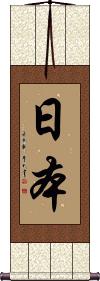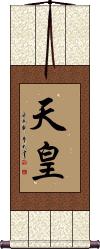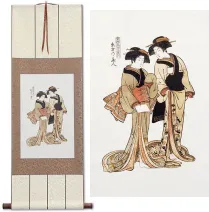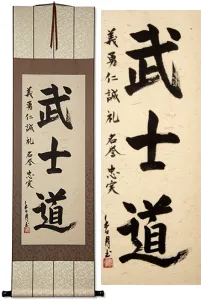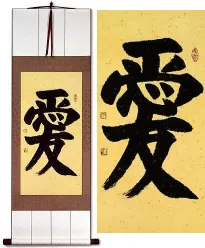Many custom options...
And formats...

Japan in Chinese / Japanese...
Buy a Japan calligraphy wall scroll here!
Personalize your custom “Japan” project by clicking the button next to your favorite “Japan” title below...
Japan
Emperor of Japan
天皇 is the title of the Emperor of Japan.
This title is used in China, Korea, and Japan to refer specifically to the Emperor of Japan.
This in-stock artwork might be what you are looking for, and ships right away...
Gallery Price: $108.00
Your Price: $59.88
Gallery Price: $200.00
Your Price: $118.88
Not the results for Japan that you were looking for?
Below are some entries from our dictionary that may match your Japan search...
| Characters If shown, 2nd row is Simp. Chinese |
Pronunciation Romanization |
Simple Dictionary Definition |
和 see styles |
huò huo4 huo wataru わたる |
More info & calligraphy: Peace / Harmony(1) (mathematics term) sum; (2) harmony; peace; (n,n-pref,adj-no) (3) Japan; Japanese-style; (noun or adjectival noun) (kana only) soft; fragile; weak; poorly built; insubstantial; (adj-nari) (archaism) tranquil; calm; quiet; peaceful; calm (at sea); lull; (given name) Wataru Harmony, peace; to blend, mix; with, unite with; respond, rhyme. |
国 see styles |
kokuki こくき |
More info & calligraphy: Guo |
國 国 see styles |
guó guo2 kuo kuniyuki くにゆき |
More info & calligraphy: Guo(out-dated kanji) (1) country; state; (2) region; (3) national government; central government; (4) home (i.e. hometown, home country); (5) (archaism) province (of Japan); (6) (archaism) land; earth; (personal name) Kuniyuki A country, a nation; national. |
強 强 see styles |
qiǎng qiang3 ch`iang chiang tsuyomi つよみ |
More info & calligraphy: Strong / Powerful / Force(suffix) (1) (ant: 弱・1) a little over; a little more than; (2) (ant: 弱・2) strength; the strong; (suffix) (3) powerhouse; one of the biggest; one of the most powerful; (suffix) (4) (after a number on the Japan Meteorological Agency seismic intensity scale; e.g. 5強) (ant: 弱・3) -upper (seismic intensity); (personal name) Tsuyomi Strong, forceful, violent; to force; to strengthen. |
磬 see styles |
qìng qing4 ch`ing ching kei / ke けい |
More info & calligraphy: Khánhsounding stone; qing; ancient Chinese chime shaped like a chevron (inverted 'v'), orig. of stone, today often metal, in Japan primarily used at Buddhist temples; (given name) Kei A piece of flat stone or metal, used as a gong, or for musical percussion. |
道 see styles |
dào dao4 tao wataru わたる |
More info & calligraphy: Daoism / Taoism(1) (abbreviation) (See 道・みち・1) road; path; street; route; (2) (See 道・みち・5) way; set of practices; rules for conducting oneself; (3) (abbreviation) (in Japanese schools) (See 道徳教育) moral education; (4) Buddhist teachings; (5) Taoism; (6) administrative region of Japan (Hokkaido); (7) (hist) administrative region of Japan (Tokaido, Tosando, etc.); (8) province (administrative region of Korea); (9) circuit (administrative region of China); (10) (hist) province (Tang-era administrative region of China); (personal name) Wataru mārga. A way, road; the right path; principle, Truth, Reason, Logos, Cosmic energy; to lead; to say. The way of transmigration by which one arrives at a good or bad existence; any of the six gati, or paths of destiny. The way of bodhi, or enlightenment leading to nirvāṇa through spiritual stages. Essential nirvāṇa, in which absolute freedom reigns. For the eightfold noble path v. 八聖道.; The two Ways: (1) (a) 無礙道 or 無間道 The open or unhindered way, or the way of removing all obstacles or intervention, i. e. all delusion; (b) 解脫道 the way of release, by realization of truth. (2) (a) 難行道 The hard way of "works", i. e. by the six pāramitā and the disciplines. (b) 易行道 the easy way salvation, by the invocation of Amitābha. (3) (a) 有漏道 The way of reincarnation or mortality; (b) 無漏 the enlightened way of escape from the miseries of transmigration. (4) (a) 教道 The way of instruction; (b) 證道 the way of realization. (5) The two lower excretory organs. |
三国 see styles |
mikuni みくに |
(1) three countries; (2) (hist) (See 魏・ぎ・1,蜀・しょく・2,呉・ご・3) Three Kingdoms (in China, 220 CE-280 CE); (3) (hist) (See 新羅・しらぎ,百済・くだら,高句麗・こうくり) Three Kingdoms (in Korea, 57 BCE-668 CE); (4) (archaism) Japan, China and India; Japan, Korea and China; the whole world; (p,s,f) Mikuni |
天皇 see styles |
tiān huáng tian1 huang2 t`ien huang tien huang tennou / tenno てんのう |
More info & calligraphy: Emperor of JapanEmperor of Japan; (place-name) Tennou Deva-king; the Tang monk 道悟 Daowu of the 天皇 Tianhuang monastery at 荊州 Jingzhou. |
帝国 see styles |
teikoku / tekoku ていこく |
(1) empire; (2) (abbreviation) (hist) (See 大日本帝国) Empire of Japan |
忍者 see styles |
rěn zhě ren3 zhe3 jen che ninja にんじゃ |
More info & calligraphy: Ninja(hist) (See 忍術) ninja; person trained in ninjutsu and employed for covert purposes in feudal Japan |
日本 see styles |
rì běn ri4 ben3 jih pen yamatono やまとの |
More info & calligraphy: JapanJapan; (surname) Yamatono Japan. Buddhism was introduced there from Korea in the sixth century, and in the seventh from China. |
日航 see styles |
rì háng ri4 hang2 jih hang nikkou / nikko にっこう |
More info & calligraphy: Nikko(company) Japan Airlines (abbreviation); JAL; (c) Japan Airlines (abbreviation); JAL |
東京 东京 see styles |
dōng jīng dong1 jing1 tung ching toukei / toke とうけい |
More info & calligraphy: TokyoTokyo; (place-name) Luoyang, China |
琉球 see styles |
liú qiú liu2 qiu2 liu ch`iu liu chiu ryuukyuu / ryukyu りゅうきゅう |
More info & calligraphy: Ryukyu(See 沖縄) Ryukyu; chain of southwestern Japanese islands comprising Okinawa Prefecture; (place-name) Ryūkyū |
神風 see styles |
jinpuu / jinpu じんぷう |
More info & calligraphy: Kamikaze / Divine Wind |
富士山 see styles |
fù shì shān fu4 shi4 shan1 fu shih shan fujiyama ふじやま |
More info & calligraphy: Mt. FujiMount Fuji; Mt. Fuji; Fujiyama; Fuji-san; (place-name, surname) Fujiyama |
淨土宗 净土宗 see styles |
jìng tǔ zōng jing4 tu3 zong1 ching t`u tsung ching tu tsung Jōdo Shū |
Pure Land Buddhism The Pure-land sect, whose chief tenet is salvation by faith in Amitābha; it is the popular cult in China, also in Japan, where it is the Jōdo sect; it is also called 蓮宗(蓮花宗) the Lotus sect. Established by Hui-yuan 慧遠 of the Chin dynasty (317— 419), it claims P'u-hsien 普賢 Samantabhadra as founder. Its seven chief textbooks are 無量淸淨平等覺經; 大阿彌陀經; 無量壽經; 觀無量壽經; 阿彌陀經; 稱讚淨土佛攝受經; and 鼓音聲三陀羅尼經. The淨土眞宗 is the Jōdo-Shin, or Shin sect of Japan. |
シャボン see styles |
japon ジャポン |
More info & calligraphy: Shavvon |
ラクスマン see styles |
rakusuman ラクスマン |
More info & calligraphy: Laxman |
下 see styles |
xià xia4 hsia shimo しも |
down; downwards; below; lower; later; next (week etc); second (of two parts); to decline; to go down; to arrive at (a decision, conclusion etc); measure word to show the frequency of an action (1) (ant: 上・かみ・1) lower reaches (of a river); (2) bottom; lower part; (3) lower half (of the body, esp. the privates); feces (faeces); urine; menses; (4) end; far from the imperial palace (i.e. far from Kyoto, esp. of western Japan); (can be adjective with の) (5) dirty (e.g. dirty jokes, etc.); (place-name, surname) Shimo hīna, adhara. Below, lower, inferior, low; to descend, let down, put down. |
伝 see styles |
chuán chuan2 ch`uan chuan fu ふ |
Japanese variant of 傳|传 (1) legend; tradition; (2) biography; life; (3) method; way; (4) horseback transportation and communication relay system used in ancient Japan; (surname) Fu |
倭 see styles |
wō wo1 wo yamato やまと |
dwarf; Japanese (derog.) (old) (1) (mathematics term) sum; (2) harmony; peace; (n,n-pref,adj-no) (3) Japan; Japanese-style; (1) Yamato; ancient province corresponding to modern-day Nara Prefecture; (2) (ancient) Japan; (can act as adjective) (3) Japanese; (surname, given name) Yamato |
坪 see styles |
píng ping2 p`ing ping hei / he へい |
a plain; ping, unit of area equal to approx. 3.3058 square meters (used in Japan and Taiwan) (1) tsubo; traditional unit of land area, approx. 3.3 square meters; (2) tsubo; traditional unit of fabric or paper area, approx. 9.18 square centimeters; (3) tsubo; traditional unit of leather or tile area, approx. 918 square centimeters; (4) (See 立坪) cubic tsubo (approx. 6 cubic metres); (surname) Hei |
姓 see styles |
xìng xing4 hsing sei(p); shou(ok); sou(ok) / se(p); sho(ok); so(ok) せい(P); しょう(ok); そう(ok) |
family name; surname; to be surnamed ... (1) surname; family name; (2) (せい only) (See 姓・かばね・1) hereditary title (used in ancient Japan to denote rank and political standing) family |
宗 see styles |
zōng zong1 tsung motoi もとい |
school; sect; purpose; model; ancestor; clan; to take as one's model (in academic or artistic work); classifier for batches, items, cases (medical or legal), reservoirs (1) (rare) origin; source; (2) (rare) virtuous ancestor; (given name) Motoi Ancestors, ancestral; clan; class, category. kind; school, sect; siddhānta, summary, main doctrine, syllogism, proposition, conclusion, realization. Sects are of two kinds: (1) those founded on principles having historic continuity, as the twenty sects of the Hīnayāna, the thirteen sects of China, and the fourteen sects of Japan: (2) those arising from an individual interpretation of the general teaching of Buddhism, as the sub-sects founded by Yongming 永明 (d. 975), 法相宗, 法性宗, 破相宗, or those based on a peculiar interpretation of one of the recognized sects, as the Jōdo-shinshū 淨土眞宗 found by Shinran-shōnin. There are also divisions of five, six, and ten, which have reference to specific doctrinal differences. Cf. 宗派. |
帝 see styles |
dì di4 ti mikado みかど |
emperor emperor (of Japan); mikado; (female given name) Mikado Ruler, sovereign; translit. t. |
弱 see styles |
ruò ruo4 jo jaku じゃく |
weak; feeble; young; inferior; not as good as; (following a decimal or fraction) slightly less than (suffix) (1) (ant: 強・1) a little less than; a little under; slightly fewer than; (2) (ant: 強・2) weakness; the weak; low (setting); (suffix) (3) (after a number on the Japan Meteorological Agency seismic intensity scale; e.g. 5弱) (ant: 強・4) -lower (seismic intensity) weak |
戎 see styles |
róng rong2 jung munemori むねもり |
generic term for weapons (old); army (matters); military affairs Ebisu; god of fishing and commerce; (1) (archaism) peoples formerly of northern Japan with distinct language and culture (i.e. the Ainu); (2) provincial (i.e. a person who lives far from the city); (3) brutish, unsophisticated warrior (esp. used by Kyoto samurai to refer to samurai from eastern Japan); (4) (derogatory term) foreigner; barbarian; (personal name) Munemori |
旧 see styles |
kyuu / kyu きゅう |
(prefix) (1) old; former; ex-; (2) the old; old things; old customs; (3) old times; bygone days; (n,pref) (4) (abbreviation) (See 旧暦) Japan's old (lunisolar) calendar |
栂 see styles |
togasaki とがさき |
(kana only) southern Japanese hemlock (species of conifer native to Japan, Tsuga sieboldii); (surname) Togasaki |
Click here for more Japan results from our dictionary
The following table may be helpful for those studying Chinese or Japanese...
| Title | Characters | Romaji (Romanized Japanese) | Various forms of Romanized Chinese | |
| Japan | 日本 | nippon / nihon nipon / nihon | rì běn / ri4 ben3 / ri ben / riben | jih pen / jihpen |
| Emperor of Japan | 天皇 | ten nou / tennou / ten no | tiān huáng tian1 huang2 tian huang tianhuang | t`ien huang tienhuang tien huang |
Successful Chinese Character and Japanese Kanji calligraphy searches within the last few hours...
